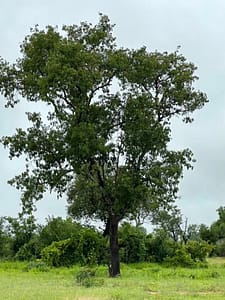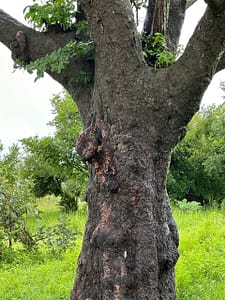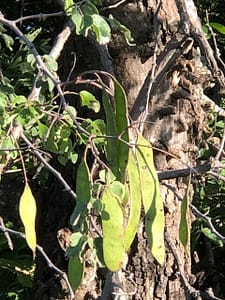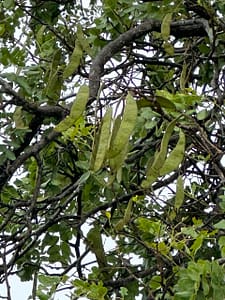



Botanical Name: Erythrophleum africanum
Common Name: Ordeal Tree, Kayimbi, Mukoso, Kabulwebulwe, Mubako, Museshe, Kalunguti, Mungansa
Plant Family: Fabaceae (Legume Family) Caesalpinoideae
Growth Form, Habitat and Distribution: A medium-sized semi-deciduous tree with a tall, straight trunk and upward spreading branches with a closed, rounded crown. Occurs widely across Zambia in most woodland types, but not in the Gwembe valley. Similar to Burkea africana and Erythropleum suaveolens (also Ordeal Tree), but the latter is confined to northern Zambia gallery forests and has shiny, pointed leaflets and 2 to 3 pairs of pinnae.
Size: Height up to 18m, spread 5 to 9m.
Bark: Reddish, becoming dark grey-brown with uniform rectangular scales. When damaged exudes a hardening red sap.
Leaves: Clustered at branch ends, compound, bipinnate with 3 to 4 pairs of opposite pinnae each with 8 to 17, alternate, densely-arranged, elliptical, papery, grey-green leaflets, velvety below (2.5 to 5cm) angled to the rachis. Petiole 1.5 to 5cm.
Flowers: Dioecious. In dense groups of spikes (up to 10cm) of small, sweet-scented, fluffy (stamens), white to yellowish (5mm), August to October, producing much nectar.
Fruit: Flat, brown, smooth, elliptical, dehiscent pods (up to 18cm) ripening May to September, splitting on both sides. 1 or 6 flat glossy brown seeds attached to the pod.
Uses: The reddish-brown wood is resistant to bore attack and polishes well. Bark and roots contain an lethal alkaloid.
